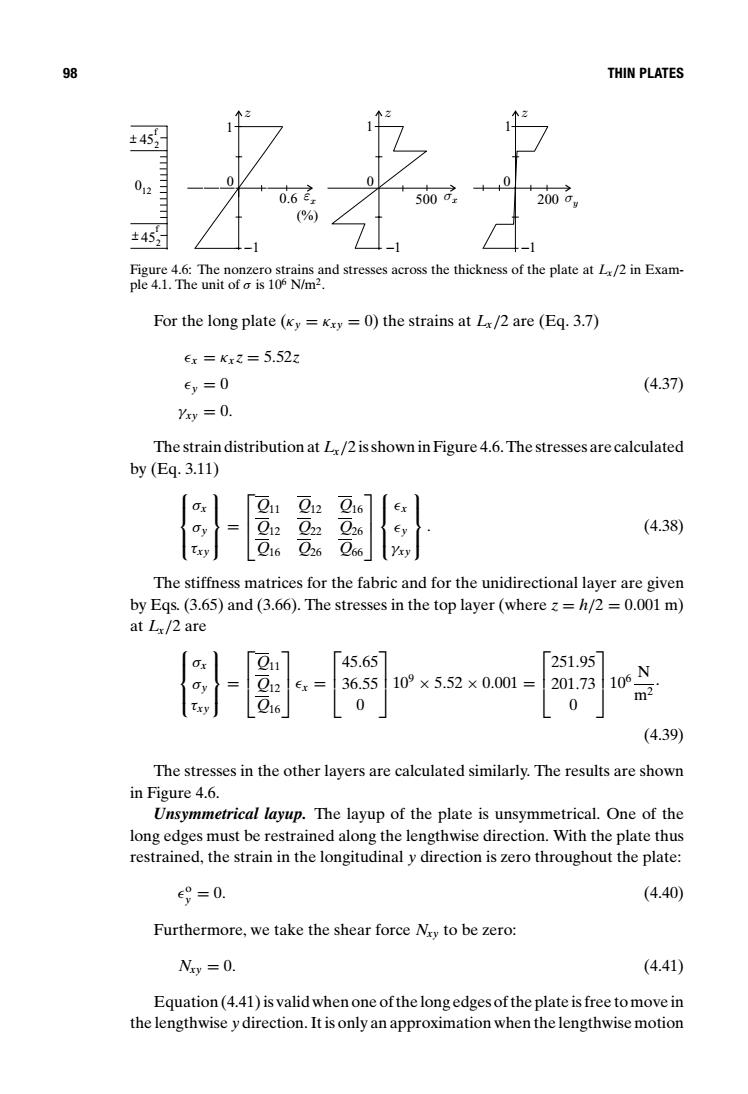正在加载图片...

98 THIN PLATES ±45 012 0 .0 0.6 5000 2000g % ±452 Figure 4.6:The nonzero strains and stresses across the thickness of the plate at L/2 in Exam- ple 4.1.The unit of o is 106 N/m2. For the long plate(Ky=Kty =0)the strains at Lx/2 are (Eq.3.7) Ex =Kx=5.52z Ey=0 (4.37) xy=0. The strain distribution at Lr/2 is shown in Figure 4.6.The stresses are calculated by(Eq.3.11) Ox Q11 012 Q16 1 226 (4.38) Q16 Q66 The stiffness matrices for the fabric and for the unidirectional layer are given by Egs.(3.65)and(3.66).The stresses in the top layer (where z=h/2=0.001 m) at Lx/2 are 45.65 251.95 36.55 109×5.52×0.001 201.73 106 N Q16 0 0 (4.39) The stresses in the other layers are calculated similarly.The results are shown in Figure 4.6. Unsymmetrical layup.The layup of the plate is unsymmetrical.One of the long edges must be restrained along the lengthwise direction.With the plate thus restrained,the strain in the longitudinal y direction is zero throughout the plate: e8=0. (4.40) Furthermore,we take the shear force Nry to be zero: Nxy =0. (4.41) Equation(4.41)is valid when one of the long edges of the plate is free to move in the lengthwise y direction.It is only an approximation when the lengthwise motion98 THIN PLATES z 0 −1 1 0.6 εx z 0 −1 1 500 σx z 0 −1 1 200 σy (%) 012 45f +_ +_ 2 45f 2 Figure 4.6: The nonzero strains and stresses across the thickness of the plate at Lx/2 in Example 4.1. The unit of σ is 106 N/m2. For the long plate (κy = κxy = 0) the strains at Lx/2 are (Eq. 3.7) x = κx z = 5.52z y = 0 (4.37) γxy = 0. The strain distribution at Lx/2 is shown in Figure 4.6. The stresses are calculated by (Eq. 3.11) σx σy τxy = Q11 Q12 Q16 Q12 Q22 Q26 Q16 Q26 Q66 x y γxy . (4.38) The stiffness matrices for the fabric and for the unidirectional layer are given by Eqs. (3.65) and (3.66). The stresses in the top layer (where z = h/2 = 0.001 m) at Lx/2 are σx σy τxy = Q11 Q12 Q16 x = 45.65 36.55 0 109 × 5.52 × 0.001 = 251.95 201.73 0 106 N m2 . (4.39) The stresses in the other layers are calculated similarly. The results are shown in Figure 4.6. Unsymmetrical layup. The layup of the plate is unsymmetrical. One of the long edges must be restrained along the lengthwise direction. With the plate thus restrained, the strain in the longitudinal y direction is zero throughout the plate: o y = 0. (4.40) Furthermore, we take the shear force Nxy to be zero: Nxy = 0. (4.41) Equation (4.41) is valid when one of the long edges of the plate is free to move in the lengthwise y direction. It is only an approximation when the lengthwise motion